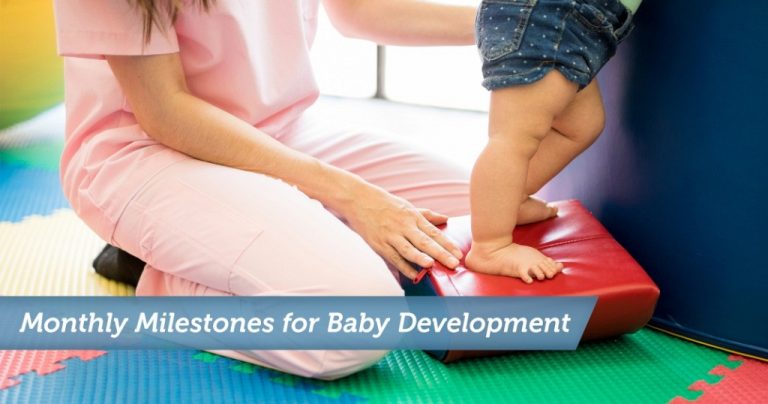
Monthly Milestones for Baby Development
Age-appropriate Baby Developmental Milestones from Birth through Six Months:
What are your baby’s monthly milestones and when should they happen?
Every child is different and will reach essential milestones at different stages throughout the baby’s growth. If you’re a new parent and are facing some concerns about your baby’s development, our rehabilitation physical therapy facility has prepared some information about typical gross motor skills from birth through six months.
Baby Development, Month-by-Month
Infants desire to be in the fetal position. You’ll observe this when they’re on their tummy, back, and sitting. They will perform spontaneous movements with decreased control. By one month your child may be able to slightly lift their head off a resting surface.
By three months, a child starts to develop increased motor control and will decrease their spontaneous movements and will hold their head to the midline on their tummy, back, and while sitting. They can turn their head in both directions to look at toys or people.
Four months is a critical month where you’ll see the most observable changes. When your child is on their tummy they will begin to bring their head to a 90-degree angle and prop up onto their forearms. They will demonstrate increased head and neck control and will start to bring their hands together. You can attempt to lift your child from their back to sitting by using their arms (pull-to-sit) and your child will be able to support their head all the way from their back to upright sitting.
At five months, your baby will start performing the “swimming” posture. They lift their head, arms, and legs into the air when on their belly. They will also start a chin tuck when performing a pull-to-sit and demonstrate independence by lifting their head up while on their back. Around five months, your child may also discover their feet. They’ll start lifting their bottom-up off the ground and play with their toes. This is a good indicator of core strength and that your child will begin crawling soon. Your child will be able to prop-sit but will not be the best at sitting on their own just yet.
Six months is the age when segmental purposeful rolling begins. Your child will be able to dissociate their upper body from the lower body and perform segmental rolling. Rolling and pivoting while on their tummy are the main means of locomotion. You will notice when holding your child in a standing position that they’ll want to bounce up and down. When performing pull-to-sit your child may place their feet down and desire to go right to standing. They can perform sitting with support at their back and will demonstrate placing arms forward to keep their balance.
Tips for Parents (4 to 6-month skill-builders)
If you have more than one child, you know that each child is different and will progress toward these fine motor skills at different stages of their development. The following skill-builders can help your newborn baby reach his or her age-appropriate developmental milestones.
- Place your baby belly-down on the floor for short practice sessions throughout the day (not at nap-times or bedtime, however, because of the risk of SIDS). Never leave your baby alone while he or she is performing this activity. Always monitor their fatigue level and ensure that his or her mouth and nose are clear of pillows, blankets, etc., so that your infant’s breathing isn’t obstructed. Always pay close attention and put your infant’s safety first.
- Give your baby a variety of objects to reach for. Offer toys that fit in one hand as well as bigger objects that require a two-handed grip. Vary the size, color, texture, etc. of the toy.
- Create an open floor, playful baby gym. Simply spread a blanket over soft floorings, like low-pile carpeted surfaces (avoid linoleum and hardwood surfaces as this would be too hard of a surface for your baby to exercise). Give your baby plenty of floor space and time to roll and flip as he or she pleases.
If you have questions when it comes to baby development and your baby’s progress, contact one of our pediatric clinics for pediatric physical therapy. We have therapists who specialize in developmental milestones and they would be happy to get to know your baby and help them reach their full potential.
Reviewed by: Holly Lookabaugh-Deur
PT, DSc, GCS, CEEAA
Holly is a practicing physical therapist, partner and Director of Clinical Services at Ivy Rehab Network with more than 40 years of experience in sports management with young athletes, and is board certified as a geriatric clinical specialist and certified exercise expert for aging adults. Deuer is certified as an aquatic and oncology rehabilitation specialist and serves as adjunct faculty at Central Michigan University and Grand Valley State University.
References:
Schmitz & O’Sullivan. (2014). Physical Rehabilitation: Assessment and Treatment, 6th Edition. Philadelphia: F.A. Davis Company.
Kessler & Martin (2007). Neurologic Interventions for Physical Therapy, 2nd Edition. St. Louis: Saunders.
The medical information contained herein is provided as an information resource only, and does not substitute professional medical advice or consultation with healthcare professionals. This information is not intended to be patient education, does not create any patient-provider relationship, and should not be used as a substitute for professional diagnosis, treatment or medical advice. Please consult with your healthcare provider before making any healthcare decisions or for guidance about a specific medical condition. If you think you have a medical emergency, call your doctor or 911 immediately. IvyRehab Network, Inc. disclaims any and all responsibility, and shall have no liability, for any damages, loss, injury or liability whatsoever suffered as a result of your reliance on the information contained herein.